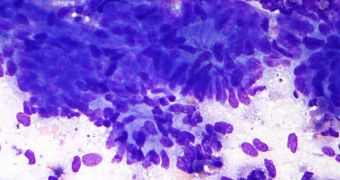A report by Case Western Reserve University (CWRU) experts indicates that it may be possible to use nanoscale chains to deliver chemotherapy drugs within tumor cells, and then have the compounds explode. This approach would spread the drugs throughout the damaged cells, destroying them.
When compared to traditional chemotherapy delivery, the new approach fared much better in inhibiting tumor growth, extended life spans for longer periods of time, killed off more cancer cells, and resulted in fewer side effects, the team reports. The trials were conducted on lab mice and rats.
This approach to addressing cancer is the result of a collaboration between doctors and engineers at the university. Its main advantage over standard chemotherapy is that it does not affect healthy cells.
Usually, this class of drugs causes extensive damage to healthy tissue around tumors, since its members act indiscriminately, on all cell types. This is the reason chemotherapy has so many side effects.
By loading the drug doxorubicin onto nanochains, scientists can also reduce the quantities needed in order to effectively destroy cancer cells. This further contributes to reducing the severity of adverse effects.
“Other nanotechnology has been used to get a drug inside a tumor, but once the drug gets in the door, it stays by the door, missing most of the building,” researcher Efstathios Karathanasis explains.
“We used a different kind of nanotechnology to smuggle the drug inside the tumor and to explode the bomb, releasing the drug in its free form to spread throughout the entire tumor,” he goes on to say.
Karathanasis, who was the leader of the CWRU research group, holds an appointment as a biomedical engineering professor at the university. Details of the new study appear in the latest online issue of ACS Nano, a journal published by the American Chemical Society.
CWRU investigators say that the key to success is creating a chain made of magnetic iron oxide particles, which have a liposome containing doxorubicin attached to them. A day after they are injected in the body, and make their way to the tumors, the bombs are exploded.
This is done by placing a solenoid – a wired coil – outside the body, and passing an electrical current through it. This creates a radiofrequency field that causes the magnetic nanoparticles to break apart from each other, ripping the liposome apart, and spreading the chemotherapy drug throughout the cell.
Rats usually survive 15 days on traditional therapy. When the new approach was applied on, they survived for 25 days. Rodents that got the treatment twice were able to hold on for 46 days, a 300 percent improvement in survival time, Science Blog reports.
“There are probably different mechanisms of growth in the different models, which indicates this technology will probably work in different types of cancer,” CWRU School of Medicine vice chair and associate professor, Ruth Keri, explains.
“This is a really clever and novel approach to targeted delivery. But, we need much more testing,” she concludes.

 14 DAY TRIAL //
14 DAY TRIAL //